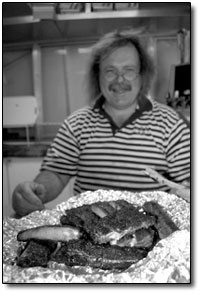|
|
||
|
A smoky day by Chef Boy Ari here will always be people to whom “barbecue” means the same thing as “grill.” Meanwhile, there are those who’ll swear on the Alamo that barbecue cannot and will not ever exist outside of Texas – unless exported by a Texan. Such things are also said in Kansas City. And there are those who would take me out back and shoot me for not calling Tennessee home of the one true ‘cue. Outside of Tennessee, Southern barbecue lovers are more molasses than spitfire, and less rabid at claiming their own as best. Nonetheless, most barbecue scholars pinpoint the cuisine’s origin in the Caribbean, whence it made landfall in the American South (this is disputed, of course, by certain Texan and Tennessean scholars who argue the impossibility of something being born outside of the only region where it truly exists). One interesting etymological theory traces the source of the word “barbecue” to Southern roadhouses advertising “Bar, Beer, Cues.” But with no reference to the slow-cooked meat itself, this theory must be considered rather weak sauce. What lies beyond dispute, even in Texas, is that I drove south down Montana’s Bitterroot Valley one recent hot August day, and the whole valley was filled with forest fire smoke. I could seriously have saved on gas by pulling over and whipping out some meat and setting it on the warm hood to slow-cook in the particulate remains of 10,000 trees. But that would have been some weak sauce, too, compared with what was to come. I continued on my trajectory toward Stevensville, where the Montana State Barbecue Championships were in progress. There, I would sample the entries of more than 25 contestants competing in four categories: barbecue chicken, beef brisket, pork ribs and pork butt.* (*A note about pork butt. While the name draws attention to the animal’s posterior, it turns out that’s the source of the ham – not the pork butt. For some reason, pork butt describes one of two cuts derived from the shoulder – the other cut being the “picnic.”) Within these competition categories, chicken is an anomaly, because it’s usually tender on arrival. The red meat cuts, on the other hand, demonstrate the true power of warm smoke to slowly, slowly, slowly cook away toughness by melting cartilage and gristle, resulting in falling-apart-tender meat. Grilling, meanwhile, involves placing the meat directly above the heat source and cooking it relatively quickly, resulting in the familiar spectrum of rare to well-done in the finished product. With barbecue, it’s all well-done.
Within these competition categories, chicken is an anomaly, because it’s usually tender on arrival. The red meat cuts, on the other hand, demonstrate the true power of warm smoke to slowly, slowly, slowly cook away toughness by melting cartilage and gristle, resulting in falling-apart-tender meat. Grilling, meanwhile, involves placing the meat directly above the heat source and cooking it relatively quickly, resulting in the familiar spectrum of rare to well-done in the finished product. With barbecue, it’s all well-done. My first stop was the Church of Swinetology, which had made the trip all the way from Portland, Ore. While I was sampling their fine brisket and non-weak sauce, a boy walked by. On his way back from the judging table, he was handing out samples of his dad’s brisket. Unlike most of the contestants, who were offsetting their expenses by selling plates of barbecue to the public, this Spokane-based team, called Bud-E’s BBQ and captained by Lance Simon, wasn’t selling its product. I followed the boy back to Bud-E’s BBQ where I met Lance and sampled ribs, butt and more brisket. I missed his chicken, which has won two of the last four Montana State Barbecue Championships. But that brisket was very well done with amazing flavor. And as it turned out, I wasn’t the only one who thought so: Bud-E’s won the weekend’s best brisket award. I wasn’t even going to stop at Woody and The Boners, of Molalla, Ore., because I thought their name was dorky. But boy was I glad to get over my shallow prejudgments. Their beans provided such an enlightening experience that I would endorse creating a bean category in future competitions. A blend of butter, lima, garbanzo, kidney, black and pinto beans mixed with tomatoes, onions, burger, maple syrup, brown sugar, ketchup, mustard, chili powder, bacon, garlic, pepper and salsa, slow-cooked and served alongside their pulled pork, those beans earned Woody and the Boners the right to call themselves whatever they want. I wound up at Reservation Ribs, out of Fort Belknap, Mont., home of the Assiniboine and Gros Ventre tribes, whose signature dish, apparently the Cowboy Cocktail – layers of pulled pork, coleslaw and beans in a transparent cup – was the talk of the event. Jim Tucker won points for Reservation Ribs by telling me where, exactly, his meat came from: a ranch in Whitehall, Mont. On the way out, I said goodbye to my friends at Bud-E’s, and Lance gave me a whole pork butt and some ribs – about 10 pounds of meat! Bloated and satisfied, I headed for my car. Driving home on the Eastside Highway, I approached the railway car sitting in the field announcing Knucklehead’s BBQ. Why, I wondered, had not Knucklehead entered the fray down the road? I stopped, and sure enough the doctor was in. “Too busy here,” he explained. “Got a catering gig for Hoyt Axton’s widow tonight, all kinds of stuff.” While I chomped into a Knucklehead brisket that was juicy enough to quench any thirst, he performed a masticatory analysis of Bud-E’s pork butt. “Not bad,” Dr. Knucklehead admitted, putting his Texan status on the line. •
|


